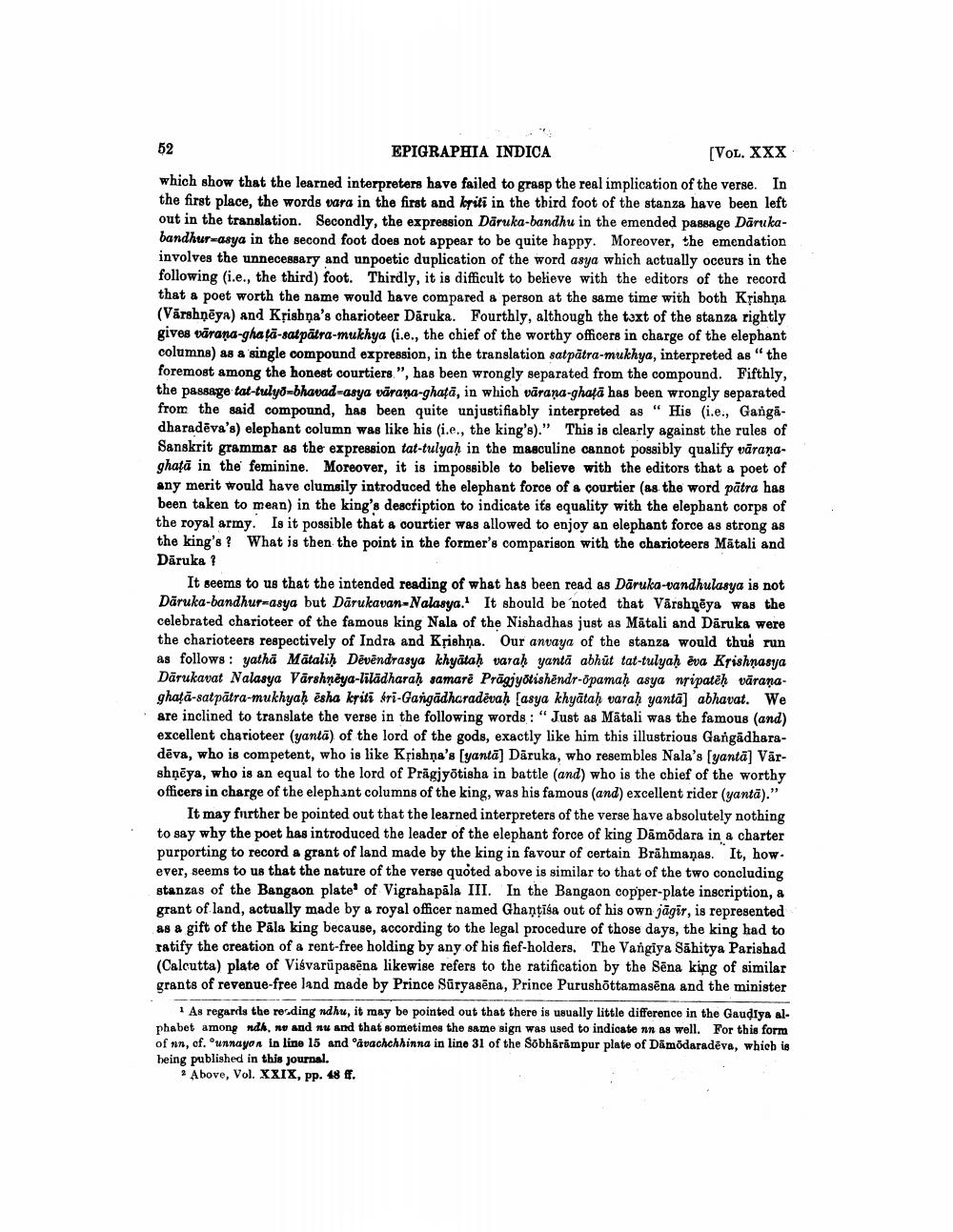________________
52
EPIGRAPHIA INDICA
[VOL. XXX
which show that the learned interpreters have failed to grasp the real implication of the verse. In the first place, the words vara in the first and kriti in the third foot of the stanza have been left out in the translation. Secondly, the expression Dāruka-bandhu in the emended passage Därukabandhur-asya in the second foot does not appear to be quite happy. Moreover, the emendation involves the unnecessary and unpoetic duplication of the word asya which actually occurs in the following (i.e., the third) foot. Thirdly, it is difficult to believe with the editors of the record that a poet worth the name would have compared a person at the same time with both Krishna (Värshņēya) and Krishna's charioteer Dăruka. Fourthly, although the text of the stanza rightly gives vārana-ghatá-satpätra-mukhya (i.e., the chief of the worthy officers in charge of the elephant columns) as a single compound expression, in the translation satpätra-mukhya, interpreted as "the foremost among the honest courtiers", has been wrongly separated from the compound. Fifthly, the passage tat-tulyo-bhavad-asya vārana-ghatā, in which varana-ghaļā has been wrongly separated from the said compound, has been quite unjustifiably interpreted as " His (i.e., Gangadharadēva's) elephant column was like his (i.e., the king's)." This is clearly against the rules of Sanskrit grammar as the expression tat-tulyaḥ in the masculine cannot possibly qualify vāranaghatā in the feminine. Moreover, it is impossible to believe with the editors that a poet of any merit would have clumsily introduced the elephant force of a courtier (as the word pätra has been taken to mean) in the king's desctiption to indicate its equality with the elephant corps of the royal army. Is it possible that a courtier was allowed to enjoy an elephant force as strong as the king's? What is then the point in the former's comparison with the charioteers Mātali and Dăruka?
It seems to us that the intended reading of what has been read as Däruka-vandhulasya is not Dāruka-bandhur-asya but Darukavan-Nalasya. It should be 'noted that Värshpēya was the celebrated charioteer of the famous king Nala of the Nishadhas just as Mätali and Däruka were the charioteers respectively of Indra and Kțishna. Our anvaya of the stanza would thus run as follows: yatha Mätalih Dēvēndrasya khyātaḥ varah yantă abhūt tat-tulyah eva Krishnasya Dārukavat Nalasya Värshneya-liladharah samare Prāgjyotishëndr-opamah asya nipatēh vāranaghatā-satpätra-mukhyah esha kriti fri-Gangādharadevah (asya khyātah varah yanta] abhavat. We are inclined to translate the verse in the following words : "Just as Mätali was the famous (and) excellent charioteer (yanta) of the lord of the gods, exactly like him this illustrious Gangadharadēva, who is competent, who is like Krishna's (yantā] Däruka, who resembles Nala's (yantā] Värshņēya, who is an equal to the lord of Prāgjyotisha in battle (and) who is the chief of the worthy officers in charge of the elephant columns of the king, was his famous (and) excellent rider (yantā)."
It may further be pointed out that the learned interpreters of the verse have absolutely nothing to say why the poet has introduced the leader of the elephant force of king Damodara in a charter purporting to record a grant of land made by the king in favour of certain Brāhmanas. It, however, seems to us that the nature of the verse quoted above is similar to that of the two concluding stanzas of the Bangaon plate of Vigrahapala III. In the Bangaon copper-plate inscription, a grant of land, actually made by a royal officer named Ghanţisa out of his own jagir, is represented as a gift of the Pāla king because, according to the legal procedure of those days, the king had to ratify the creation of a rent-free holding by any of his fief-holders. The Vangiya Sahitya Parishad (Calcutta) plate of Visvarüpasēna likewise refers to the ratification by the Sēna king of similar grants of revenue-free land made by Prince Süryasēna, Prince Purushottamasēna and the minister
1 As regards the rording ndhu, it may be pointed out that there is usually little difference in the Gaudiya alphabet among ndh, nu and nu and that sometimes the same sign was used to indicate nn as well. For this form of nn, of. unnayon in line 15 and Ravachchhinna in line 31 of the Sobhārāmpur plate of Damodaradēva, which is heing published in this journal.
2 Above, Vol. XXIX, pp. 48 ff.




